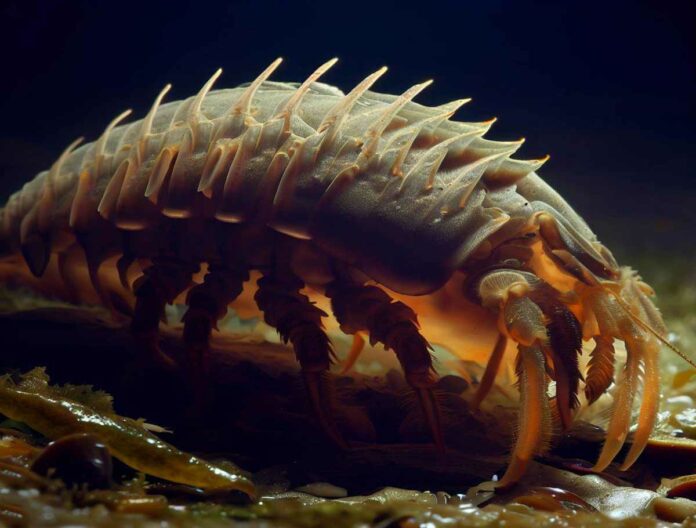The presence of artificial night-time light has been found to disturb the natural camouflage abilities of a remarkable coastal woodlouse, according to recent research conducted by the University of Exeter. This inch-long creature, known as the sea slater, is commonly found along the high-tide line in coastal regions of the UK and Europe. The study discovered that the sea slaters, which are renowned for their color-changing capabilities to blend in with their surroundings and evade predators, experienced difficulties due to different types of light sources.
In their investigation, the researchers examined the impact of a single-point light source, which creates distinct shadows, and diffuse light, similar to the skyglow observed near towns and cities. Surprisingly, while the sea slaters were unaffected by the single light source and were able to maintain their camouflage, the diffuse light caused them to become paler, thus making them more conspicuous against a dark background.
Kathryn Bullough, who led the study as part of her masters at the Centre for Ecology and Conservation on Exeter’s Penryn Campus in Cornwall, emphasized the importance of understanding the consequences of brightening night skies on the natural world. She stated, “We know artificial light causes all sorts of negative effects for animals and plants, but our results show that shadow-casting light can have very different impacts to diffuse skyglow, even when both have the same overall brightness.”
Under the influence of point-source light, the sea slaters darkened their coloration and sought refuge among dark stones and shadows when available. However, exposure to diffuse light resulted in a surprising outcome as the sea slaters became lighter by an average of 27%, despite the increased risk of being spotted by predators.
Dr. Jolyon Troscianko, also from the Centre for Ecology and Conservation, speculated on the reason behind this behavior. He suggested that the sea slaters might interpret the diffuse light as a signal of approaching dawn due to their highly sensitive light vision. Nocturnal animals perceive skyglow as exceptionally bright, which could explain their unexpected response.
Coastal areas, heavily populated by humans, are particularly susceptible to light pollution, which disproportionately affects shorelines. Although sea slaters are not classified as a threatened species, they serve as a vital food source for shore birds like oystercatchers and gulls. Dr. Troscianko emphasized the significance of comprehending how human activities impact the prey of declining shore bird species within complex ecosystems.
The study received partial funding from the Natural Environment Research Council (NERC). Its findings were published in the journal Proceedings of the Royal Society B under the title “Artificial light at night causes conflicting behavioural and morphological defense responses in a marine isopod.”
Implications for Coastal Wildlife and Conservation Efforts
Light Pollution Threatens the Natural Balance
The research conducted by the University of Exeter sheds light on the detrimental effects of artificial night-time light on coastal ecosystems. With the increasing brightness of night skies worldwide, it becomes crucial to understand the repercussions for wildlife populations, especially those residing in coastal regions.
The study’s findings highlight the conflicting responses exhibited by the sea slaters, indicating that the type of light source plays a significant role in their camouflage abilities. While shadow-casting light had little impact on their natural defenses, the diffuse light, reminiscent of the skyglow near urban areas, disrupted their color-changing mechanism, making them more vulnerable to predators.
The Vulnerability of Nocturnal Adaptations
Nocturnal creatures, such as the sea slaters, have evolved to rely on darkness as a means of survival. Their exceptional light vision allows them to navigate in the dark and detect potential threats. However, the ever-increasing presence of artificial light sources poses a significant challenge to their natural adaptations.
The researchers suggest that the sea slaters’ response to diffuse light may be triggered by their sensitivity to brightness levels. As the skyglow appears intensely luminous to these nocturnal organisms, they may mistake it for the approaching dawn, resulting in unintended morphological and behavioral changes.
Protecting Coastal Wildlife
Coastal regions are at the forefront of light pollution due to their proximity to urban centers. The study emphasizes the need for conservation efforts to mitigate the negative impacts on coastal wildlife. By understanding the specific ways in which different types of artificial light affect nocturnal animals like sea slaters, scientists can propose targeted solutions to minimize disruptions to their natural behavior and habitat.
Furthermore, the decline of shore bird species adds urgency to the need for comprehensive ecosystem preservation. As sea slaters constitute a significant food source for these birds, any disturbance in their populations can have cascading effects on the entire ecosystem. Conservation initiatives should take into account the interconnectedness of species and strive for sustainable practices that balance human activities with the preservation of coastal biodiversity.
In conclusion, the research by the University of Exeter demonstrates the adverse effects of light pollution on the camouflage abilities of coastal woodlice, particularly the sea slaters. The study’s findings underscore the need for further investigation into the consequences of artificial night-time light on various nocturnal species. As efforts are made to reduce light pollution and protect natural habitats, a greater understanding of these impacts can aid in the development of effective conservation strategies to ensure the preservation of coastal ecosystems for generations to come.
JOURNAL: Proceedings of the Royal Society B Biological Sciences | DOI: 10.1098/rspb.2023.0725

